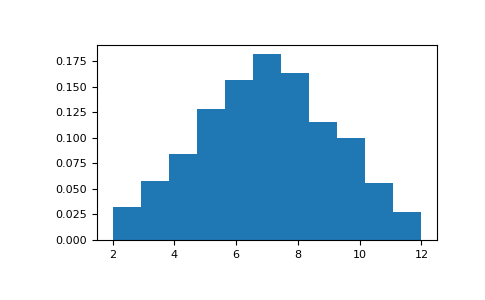numpy.random.RandomState.random_integers¶
-
RandomState.random_integers(low, high=None, size=None)¶ 低和高之间的np.int类型的随机整数(含)。
从闭合区间[低,高]中的“离散均匀”分布返回np.int类型的随机整数。如果高为无(默认值),则结果来自[1,低]。np.int类型转换为Python 2用于“短”整数的C long类型,其精度是平台相关的。
此函数已被弃用。请改用randint。
自1.11.0版起已弃用。
参数: 低:int
从分布中绘制的最低(有符号)整数(除非
high=None,在此情况下此参数是最高这样的整数)。高:int,可选
如果提供,从分布中绘制的最大(有符号)整数(如果
high=None,请参见上面的行为)。size:int或tuple的整数,可选
输出形状。如果给定形状是例如
(m, n, k),则m * n * k默认值为None,在这种情况下返回单个值。返回: out:int或ndarray的整数
size从合适的分布中随机整数的数组,或者如果size未提供,则单个这样的随机int。
也可以看看
random.randint- Similar to
random_integers, only for the half-open interval [low, high), and 0 is the lowest value if high is omitted.
笔记
要从a和b之间的N个均匀间隔的浮点数进行采样,请使用:
a + (b - a) * (np.random.random_integers(N) - 1) / (N - 1.)
例子
>>> np.random.random_integers(5) 4 >>> type(np.random.random_integers(5)) <type 'int'> >>> np.random.random_integers(5, size=(3.,2.)) array([[5, 4], [3, 3], [4, 5]])
从0到2.5之间的五个均匀间隔数字(,即,从集合
 )中选择五个随机数字:
)中选择五个随机数字:>>> 2.5 * (np.random.random_integers(5, size=(5,)) - 1) / 4. array([ 0.625, 1.25 , 0.625, 0.625, 2.5 ])
辊两面六面骰子1000次,总结结果:
>>> d1 = np.random.random_integers(1, 6, 1000) >>> d2 = np.random.random_integers(1, 6, 1000) >>> dsums = d1 + d2
以直方图显示结果:
>>> import matplotlib.pyplot as plt >>> count, bins, ignored = plt.hist(dsums, 11, normed=True) >>> plt.show()
